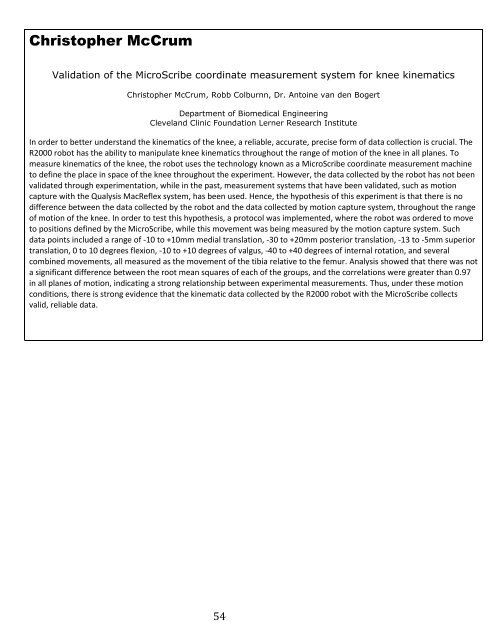student research day - Case Western Reserve University School of ...
student research day - Case Western Reserve University School of ...
student research day - Case Western Reserve University School of ...
You also want an ePaper? Increase the reach of your titles
YUMPU automatically turns print PDFs into web optimized ePapers that Google loves.
Christopher McCrum<br />
Validation <strong>of</strong> the MicroScribe coordinate measurement system for knee kinematics<br />
Christopher McCrum, Robb Colburnn, Dr. Antoine van den Bogert<br />
Department <strong>of</strong> Biomedical Engineering<br />
Cleveland Clinic Foundation Lerner Research Institute<br />
In order to better understand the kinematics <strong>of</strong> the knee, a reliable, accurate, precise form <strong>of</strong> data collection is crucial. The<br />
R2000 robot has the ability to manipulate knee kinematics throughout the range <strong>of</strong> motion <strong>of</strong> the knee in all planes. To<br />
measure kinematics <strong>of</strong> the knee, the robot uses the technology known as a MicroScribe coordinate measurement machine<br />
to define the place in space <strong>of</strong> the knee throughout the experiment. However, the data collected by the robot has not been<br />
validated through experimentation, while in the past, measurement systems that have been validated, such as motion<br />
capture with the Qualysis MacReflex system, has been used. Hence, the hypothesis <strong>of</strong> this experiment is that there is no<br />
difference between the data collected by the robot and the data collected by motion capture system, throughout the range<br />
<strong>of</strong> motion <strong>of</strong> the knee. In order to test this hypothesis, a protocol was implemented, where the robot was ordered to move<br />
to positions defined by the MicroScribe, while this movement was being measured by the motion capture system. Such<br />
data points included a range <strong>of</strong> -10 to +10mm medial translation, -30 to +20mm posterior translation, -13 to -5mm superior<br />
translation, 0 to 10 degrees flexion, -10 to +10 degrees <strong>of</strong> valgus, -40 to +40 degrees <strong>of</strong> internal rotation, and several<br />
combined movements, all measured as the movement <strong>of</strong> the tibia relative to the femur. Analysis showed that there was not<br />
a significant difference between the root mean squares <strong>of</strong> each <strong>of</strong> the groups, and the correlations were greater than 0.97<br />
in all planes <strong>of</strong> motion, indicating a strong relationship between experimental measurements. Thus, under these motion<br />
conditions, there is strong evidence that the kinematic data collected by the R2000 robot with the MicroScribe collects<br />
valid, reliable data.<br />
54
















